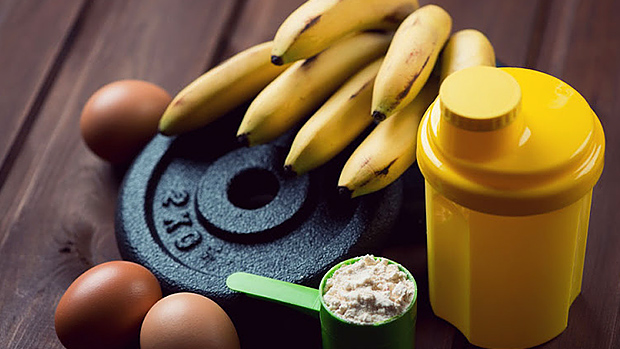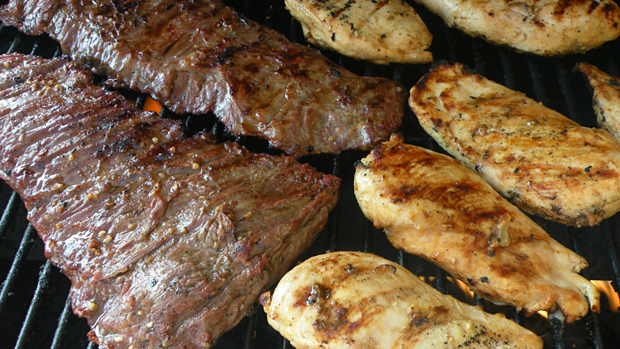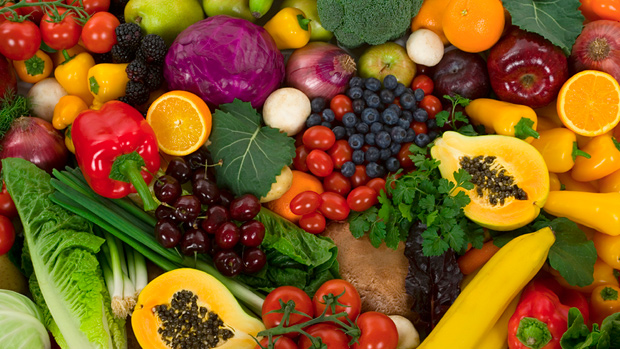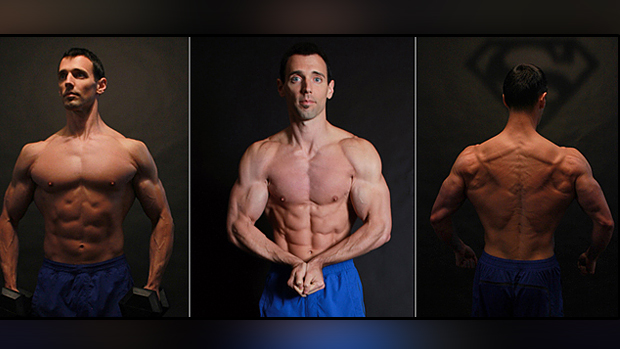Beginners trying to lose body fat don't need to follow an advanced fat loss program in order to get results. If you're fat, you're fat, and following an advanced training program won't necessarily speed up the process. All you really need to do is move.
The same can be said about newbie nutrition. Many people new to the fitness game are quick to ask how often they should be performing carb refeeds or what advanced supplements they should be taking, but all they really need to focus on are some basic guidelines.
One of the hardest things to do as a personal trainer is to get new clients to understand that what they eat and how they eat it plays a significant role in their overall progress. Even if you're not a trainer or strength coach, I'm sure many of you are often bombarded with questions and comments from friends and family members concerning nutrition.
I don't know about you, but if one more cashier blurts out, "Wow, those are a lot of eggs! Do you eat all of those?" while I go through the checkout line, I'm going to pull a Jake "The Snake" Roberts and DDT someone to the floor.

Yes, I DO eat all those eggs!
There's nothing new or revolutionary discussed in this article. Matter of fact, it's about as basic as you can get. But for most people, that's all they need!
Let's Begin
Not a day goes by where I don't hear one of the following:
- "I eat really well."
- "My diet is fine."
- "I make great food choices."
The reality is that most people aren't making good nutritional choices and most have no idea what they're putting down their pie holes. If you're eating so well, then why are you 20 pounds overweight? If your diet is so flawless, then why do you always feel lethargic and have low energy? If you make such great nutritional choices, why haven't you, while standing, been able to see your penis in over five years?
You Have No Idea
Most people have no idea what they're eating or how much. Numerous data has shown that people tend to under-report how much they really eat. Check out this chart from Dr. John Berardi:
Exhibit A.
Food Group Servings: (Perceived intake versus actual consumption.) All numbers refer to servings per day.
| Grains | Fruits | Vegs | Milk | Meat | F/O/S * | |
| Females 19 - 24 | ||||||
| Perceived | 3.2 | 2.6 | 2.6 | 3.2 | 3.5 | 2.2 |
| Consumed | 4.2 | 0.8 | 1.7 | 1.2 | 1.6 | 3.0 |
| Females 25 - 50 | ||||||
| Perceived | 2.9 | 2.2 | 2.5 | 2.3 | 3.0 | 2.1 |
| Consumed | 4.6 | 0.8 | 2.0 | 1.0 | 1.7 | 3.2 |
| Females 51+ | ||||||
| Perceived | 2.5 | 2.4 | 2.6 | 2.1 | 2.7 | 1.6 |
| Consumed | 4.7 | 1.5 | 2.2 | 1.0 | 1.7 | 3.1 |
| Males 19 - 24 | ||||||
| Perceived | 2.9 | 2.1 | 2.2 | 3.1 | 3.7 | 2.1 |
| Consumed | 5.5 | 0.6 | 2.3 | 1.6 | 2.3 | 4.1 |
| Males 25 - 50 | ||||||
| Perceived | 2.9 | 2.2 | 2.4 | 2.2 | 3.4 | 2.1 |
| Consumed | 5.9 | 0.9 | 2.5 | 1.2 | 2.5 | 4.0 |
| Males 51+ | ||||||
| Perceived | 2.7 | 2.2 | 2.5 | 2.1 | 3.1 | 1.7 |
| Consumed | 6.2 | 1.3 | 2.7 | 1.1 | 2.4 | 4.5 |
* Fats/Oils/Sweets
What Does This Show Us?
- People are eating more grains/starches than they think they are. This isn't a bad thing per se; carbohydrates have a time and place. I'm not a "carb phobe," but most people would be wise to limit their grain/starch intake to certain times of the day, especially if fat loss is one of the main goals.
- People are not eating nearly as much fruit as they think they are.
- People are not eating nearly as many veggies as they think they are. One lettuce leaf on your sandwich doesn't count as a serving, folks!
- People are not drinking as much milk (or getting enough dairy in general) as they think they are.
- People are not eating as much meat (protein) as they think they are. I'm a firm advocate of high(er) protein diets, especially for fat loss and body re-composition. As Cassandra Forsythe (soon to be a PhD in nutrition) always says, "When in doubt, eat protein."
- People are eating more fats/oils/sweets than they think they are. This doesn't mean I'm implying that "fat makes you fat." On the contrary, I feel that dietary fat is an integral component of a fat loss diet. It's about quality of fat, not quantity.
I'm more concerned about sweets. People often forget about those Oreo cookies they ate last night or that slice of apple pie (which doesn't count as a fruit by the way).
Rules to Follow
The goal now (read: not tomorrow, not next week, now) is to just make better food choices and improve your daily eating habits. There's no need to get cute or technical with things. There's no need to count calories daily, nor is there any need to worry about macronutrient percentages.
Instead, I want you to follow these simple rules for the next six to twelve months. In doing so, I can guarantee you'll feel and look better.
1 – Eat Breakfast Every Day!
This is simple. There's no excuse not to eat breakfast every day. It takes no more than two minutes to whip up a bowl of oatmeal or blend a protein shake with a piece of fruit. Anyone who says they don't have time to make breakfast in the morning is being flat-out lazy and just doesn't want to make the effort to change. Get up fifteen minutes earlier if you have to.
Studies show that people who eat breakfast on a consistent basis tend to be significantly leaner than those who don't. Additionally, breakfast is a great way to stunt the release of cortisol (a hormone that tells your body to store fat). Start each day with breakfast, no excuses.
2 – Eat Every 2-3 Hours, No Matter What!
Never skip a meal to "save calories." In doing so you're more likely to overeat later in the day. One of the worst things you can do is to go for prolonged periods of time without eating. You should eat to prevent hunger, not because you're hungry. Even if you're not hungry and it's been three hours, eat something. A protein shake with a handful of mixed nuts would suffice.
Strive for five to eight "feedings" per day. Doing so will go a long ways in keeping blood glucose levels in check and providing some arbitrary improvements in overall metabolism.
It's simple math really. If you're awake 15 hours out of the day, that equates to at least five meals (15/3 hours = 5). So if it's 9 PM and the last time you ate was 6 PM, it's time to eat again. Granted, what you eat during this time will make a difference (I wouldn't suggest a bowl of cereal or a bagel), but it stands to reason that you can and should eat a small meal prior to bed.
Don't listen to Oprah (or any dieting guru who agrees with her) when she says that she doesn't eat past "X" time at night. There's a reason why people call her a yo-yo dieter. It doesn't work.
The Perfect Pre-Bed Meal:
- Half to 1 cup low-fat cottage cheese
- 1 scoop chocolate Metabolic Drive® Protein
- 1 oz raw almonds
- Half a serving of a quality "greens" supplement
3 – Eat Lean Protein With Every Meal
Protein has the greatest Thermic Effect of Feeding (TEF) compared to fats and carbohydrates combined, which translates to more calories being burned during digestion.
Simply put, the body will burn more calories (upwards of 30%) assimilating and digesting protein than carbs (6%) and fats (3%). So for every 100 calories of protein ingested, the body will burn 30 calories just digesting it.
Additionally, protein provides essential (and non-essential) amino acids, which are the building blocks of precious lean muscle. Protein also takes longer to digest which will give you a greater feeling of satiety and prevent hunger pangs.
Use the chart provided below to find out just how many cute little furry animals you can eat!
The Protein Chart: Your Best Sources of Protein
- Food Type: Lean, complete sources of protein
- Food Timing: Eaten with every feeding opportunity
- Food Amount: 1 serving for women (size of fist)
2 servings for men (size of two palms) - Examples:
- Lean Meats: 93-95% ground beef, top round, top sirloin, chicken breast, turkey breast, ground turkey, ham, pork, ostrich, venison, bison, beef jerky (NOT Slim Jims)
- Fish: salmon, tuna, cod, trout, haddock, etc.
- Eggs: egg whites, Omega-3 whole eggs
- Low Fat Dairy: cottage cheese (skim, 1%), plain yogurt (no fruit on the bottom), part skim cheese, milk, string cheese
- Milk Protein Supplements (powder)
A Little Rant
If I hear one more registered dietician or physician mention that diets high in protein are dangerous, I'm going to go postal. First, let's make a list of things that are dangerous:
- Putting your finger in an electrical socket.
- Wearing a Yankees hat anywhere in downtown Boston.
- Responding "yes" whenever your significant other asks you, "Does this make me look fat?"
- Watching a Ben Affleck movie.
Those are dangerous. Diets high in protein are not dangerous. Many claim that high protein diets will strain or damage the kidneys. Thing is, there has never been one scientific study that has shown that diets high in protein harm the kidneys in any way in healthy individuals. I'm more likely to date Kate Beckinsdale than you are in finding a study which says high protein diets cause damage in the kidneys. (Read: Not gonna happen!)
And while there are some studies which do say that high protein diets cause renal (kidney) dysfunction, they were done on people who already had some sort of renal disease in the first place. Well, duh!
If I wasn't convincing enough, in a review titled "Dietary protein intake and renal function," published in Nutrition and Metabolism, Martin et al concluded:
"While protein restriction may be appropriate for treatment of existing renal disease, we find no significant evidence for a detrimental effect of high protein intakes on kidney function in healthy persons after centuries of a high protein Western diet."
4 – Eliminate Calorie Containing Beverages
Alcohol is basically a poison to the body, and when it's ingested the body's main objective is to get rid of it. Fat loss is impossible or at least stunted when alcohol is present in the body. The liver must metabolize and excrete all the alcohol before it can go on doing anything else.
I'm not saying a glass of wine here and there is a bad thing, but I will say that if your goal is fat loss, alcohol should be limited (if not eliminated entirely).
Other beverages on the hit list:
- Soda: Nothing but sugar and/or artificial sweeteners
- Fruit juice: Highly processed and devoid of the "good stuff" (fiber)
By eliminating calorie containing beverages from your daily diet, you're essentially reducing your daily caloric intake by quite a bit, which will equate to fat loss.
Rule of thumb: Drink at least a gallon of water per day if you're a woman, 1.5 to 2 gallons if you're a man. A great way to judge if you're drinking enough water is the color of your urine. It shouldn't be yellow; it should be clear with a hint of off-yellow tone. If it isn't, you're not drinking enough water.
5 – Ingest Vegetables And/Or Fruit Every Time You Eat
Remember, that lone leaf of lettuce you have on your sandwich doesn't count. You need to be eating vegetables and/or fruit with every meal and plenty of them.
Various fruits and vegetables offer a plethora of antioxidants, vitamins and minerals, and fiber. Buying fresh fruits and veggies will undoubtedly provide a fuller flavor compared to frozen, but in the end just eat them and quit being so stubborn. Here's a list of some vegetables and fruits and their appropriate serving sizes:
Vegetables
- 1/2 cup green pepper
- 1/2 cup red pepper
- 1/2 cup onion
- 1/2 cup mushroom
- 1 cup broccoli
- 1 cup cauliflower
- 1 cup cucumber
- 1 cup zucchini
- 1 cup beets
- 1 cup radish
- 1 cup celery
- 1 cup pumpkin
- 10 olives
- 10 baby carrots
- 10 snap green beans
- 10 medium asparagus spears
Fruits
- 1 medium pear
- 2 large peaches
- 1 large banana
- 15 strawberries
- 1 cup raspberries
- 1 cup diced watermelon
- 1 cup diced honey Dew
- 1 cup diced cantaloupe
- 2 plums
- 15 grapes
- 1/8 cup raisins
- 1 large kiwi
- 1 nectarine
- 15 cherries
- 3/4 cup blueberries
- 3 dates
- 1 large fig
- 2 lemons
- 3 limes
- 1 large grapefruit
- 1/3 cup coconut
- 1 mango
- 1 small papaya
By no means is this a comprehensive list. The important thing is to consume the vegetables and fruits that are most convenient for you and your lifestyle. As a general rule of thumb, eat all the veggies you want and limit your fruit to 2-3 servings per day.
6 – Save "Starchy" Carbs For After You Train
Use your carbs, don't wear them. When it comes to starchy carbohydrates (think pasta, rice, and potatoes), your best bet would be to save them for only after you train. Please read that again. Save your starchy carbs for only after you train (which for most is three to four times per week). The rest of the day, focus on protein, veggies/fruit, and healthy fats.
After you train your body will actually put those carbohydrates to good use: replenishing depleted glycogen stores, aiding with shuttling nutrients to muscle cells, and shutting down cortisol production (a very catabolic hormone which breaks down muscle). Your body will handle the carbs much more effectively in the hours after a workout than at any other time during the day, so save them for that time only.
The Carbohydrate Chart: Your Best Sources and When to Eat Them
| Food Type | Timing | Examples |
| Exercise Recovery Drink | During exercise only | Protein-rich recovery drinks (Mag-10®, Surge®) |
| Simple Sugars/Highly Processed Starches | Minimize intake (90% cheat foods) | Sugary sports drinks, Breakfast cereals, Soda, Fruit juice, Table sugar, Ice cream, Cake, pastries, Muffins, bagels, and other carb-rich snacks. |
| Whole Grain/Starchy Carbohydrates | Within 1-2 hours after strenuous exercise | Bread (preferably whole grain), Pasta (preferably whole grain or flax), Rice (preferably whole grain, wild, unprocessed), Potatoes (preferably sweet potatoes/yams, Oats (preferably whole oats), Cereal grains (wheat, rye, etc.) |
| Fruits and Vegetables | Eat with each feeding (with emphasis on veggies) | See list above |
7 – Eat Fat
Let's say this together: dietary fat does not make me fat. We need to focus on the quality of the fats we eat, not necessarily the quantity.
There are three types of fat – saturated, monounsaturated, and polyunsaturated. Eating all three kinds in a healthy balance can dramatically improve your health and even help you lose fat. Sounds like an oxymoron (you need to eat fat to lose fat), but when you concentrate on the "good" fats, that's what happens.
Your saturated fat should come from animal products. You can even toss in some butter or coconut oil for cooking. Your monounsaturated fat should come from mixed nuts, olives, and olive oil. Your polyunsaturated fat should come from flaxseeds, flaxseed oil, fish oil, and mixed nuts.
The Fat Chart: Your Best Sources of Fat
| Food Type | Timing | Examples |
| Saturated Fat | None: Just be sure to get 1/3 of total fat intake from these fats | nimal fats: fat in eggs, meats, butter, cheeses, etc, Coconut oil, Palm oil |
| Monounsaturated Fat | None: Just be sure to get 1/3 of total fat intake from these fats | Extra virgin olive oil, Nuts and nut butters, Avocado |
| Polyunsaturated Fat | None: Just be sure to get 1/3 of total fat intake from these fats | Flax seed/oil, Fish oil (Flameout), Nuts and nut butters, Vegetable oils |
Avoid trans fats and hydrogenated oil at all costs!
8 – Don't Worry About Minutia
Minutia: small or trivial details. Setting diets up based on percentages just doesn't make sense. When someone places protein, carbohydrate, or fat requirements in terms of percentages for a diet, it doesn't necessarily have any relevance to what that person actually needs. A diet consisting of 30% protein may be too little for one person (ingesting only 1000 kcals per day) and too high for someone else (ingesting 5000 kcals per day).
Using the above example, someone who "needs" 150 grams of protein would only be ingesting 75 grams of protein per day on a 1000 kcal per day diet (half of what he actually needs), and 375 grams of protein per day (more than double what he needs) on a 5000 kcal per day diet (again, assuming 30% protein).
Additionally, many diets are often labeled "high carbohydrate or high fat" when a specific macronutrient is over a certain percentage. Most dieticians would be quick to label a diet consisting of 35% fat as "high fat." However, if we were to take a 2000 kcal diet (with 35% of calories coming from fat) and add 200 grams (800 kcals) of carbohydrate to it without changing anything else (total calories are now 2800), a "high-fat" diet all of a sudden becomes a "low-fat" diet because the percentage of fat dropped from 35% to 25%, even though total grams of fat stayed the same.
Save your energy for time under the bar. No need to worry about trivial minutia such as macronutrient percentages.
9 – Have 10% Foods
Berardi has stated numerous times that 100% nutritional discipline is never required for optimal progress. The difference in results between 90% adherence to your nutritional program and 100% adherence is negligible.
Weekends tend to be the time when people are tempted to stray from their normal eating habits. As long as you're strict 90% of the time, those three slices of pizza you ordered on Friday night won't be the end all/be all of your success. Planned cheat meals are actually quite beneficial to fat loss in general and have actually been shown to help people get out of their fat loss plateau.
Just make sure you do the math and determine what 10% of the time really means. For example, if you're eating six meals per day for seven days of the week, that's 42 meals. Ten percent of 42 is about four. Therefore, you're allowed to "break the rules" four meals each week.
10 – Food Preparation is Key
The hardest part about eating well is making sure you can follow the rules above consistently. I can't stress enough how important food preparation is for your success. This should be your first priority!
It takes time and discipline to prepare the foods you need to be eating. Sure, it's more convenient to order fast food rather than cooking a few chicken breasts and steamed veggies for dinner. But you need to look at the food you eat as either bringing you one step closer to your goal or two steps back!
Cooking and preparing meals ahead of time will ensure that you're eating the right foods and not eating for convenience. If the good food is already there in your fridge, you're less inclined to eat the bad stuff. Make a grocery list every week and go shopping for all the foods you'll need to succeed.
What to Shop For
Try to stick to the outer perimeter while grocery shopping. This is where your fresh produce, meats, dairy, and infinitely more attractive women are. Don't shop in the middle aisles. With a few exceptions, all your grocery shopping should be done on the outer isles of the grocery store.
Here are some middle isle exceptions: tuna, old fashioned rolled oats, canned fruits in own juices, dried fruits with no additives, beans (no added sugars), some whole grain pastas, spices, brown rice, mixed nuts, natural peanut butter.
Some food for thought:
- If your food has a wrapper or a box, chances are it isn't good for you.
- If your food has ingredients you can't say, chances are it isn't good for you.
- If your food makes a claim that it's healthy, chances are it isn't good for you.
- If your food comes pre-seasoned, chances are it isn't good for you.
- Lastly, if your food makes any claims about fat loss, chances are it isn't good for you.
Wrap-Up
The above recommendations represent how I approach nutrition with the bulk of my own clients. With a few exceptions, most just need some basic structure of what, when, and how to eat for their first six months to a year of training. There's no need to worry about percentages or how often one should re-feed, or what supplements he or she should be taking.
Keep it basic, newbies!





